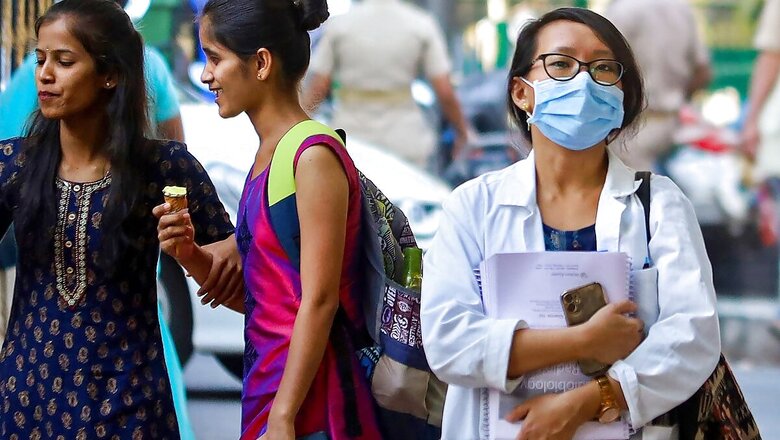Covid Positivity Rate Shows Uptick in Some States As H3N2 Cases Rise, Centre Urges More Surveillance

views
The Union Health Ministry on Saturday expressed concerns over the fresh rise in Covid-19 positivity rate in some states amid increasing cases of the seasonal influenza subtype H3N2 and said that it needed to be promptly addressed.
India on Saturday recorded 456 new coronavirus infections, taking the total number of cases to 4.46 crore, while the active cases increased to 3,406. The death toll stands at 5,30,780 with one death reported in Gujarat.
“While the COVID-19 trajectory has decreased substantially in last few months, the gradual rise in COVID-19 test positivity rates in some states is a concerning issue that needs to be promptly addressed,” Union Health Secretary Rajesh Bhushan said in a letter to states and UTs on Saturday.
The Center urged all states and union territories to adhere to the operational guidelines for integrated surveillance of respiratory pathogens that manifest as cases of severe acute respiratory infection (SARI) or influenza-like illness (ILI) (SARI).
States were also urged to assess hospital readiness, including the availability of medications, medical oxygen, and influenza and Covid-19 immunisation coverage.
Bhushan, in his letter, said that despite the low number of fresh cases, equally low number of hospitalisations and significant advances made in terms of Covid-19 vaccination coverage, there is a need to remain vigilant and focus on the five-fold strategy of test, track, treat, vaccination and adherence to Covid-appropriate behaviour.
The letter came as a meeting was held to review the current situation with the central ministries, departments and organisations concerned over concerns over the rising trend in ILI and SARI cases reported in some states and UTs across the country.
Bhushan noted that while influenza is an annual seasonal occurrence, in the present season, a variety of weather conditions and behavioural reasons — less than adequate attention to personal hygiene, coughing without adequate protection, closed indoor gatherings of people, etc. — make the environment conducive to circulation of a number of viral respiratory pathogens like Influenza A (H1N1, H3N2 etc.) and adenoviruses.
According to him, an increase in ILI/SARI is being seen nationwide as reported by states and UTs under the Integrated Disease Surveillance Programme (IDSP).
Furthermore, since the latter half of December of last year, influenza A has been on the rise, according to integrated sentinel-based surveillance of ILI and SARI.
Influenza A (H3N2) Co-morbidities
“Of particular concern is preponderance of Influenza A (H3N2) being detected in the samples being analysed in various labs. It should also be kept in mind that young children, old age people and people suffering from co-morbidites are particularly at risk and vulnerable to H1N1, H3N2, adenoviruses, etc,” he said.
Also, since January 1, nearly 25.4% of respiratory samples tested positive for adenoviruses, according to tests done by several viral research and diagnostic labs (VRDLs).
“While most of these agents typically cause a similar mild and often self-limiting illness manifesting acute respiratory infection with fever and cough, in some cases, particularly old age people, people with obesity and other co-morbidities as well as pregnant females, those infected may suffer from a more severe manifestation of these diseases requiring hospitalisation,” Bhushan underlined.
“In order to limit transmission of these diseases, it is important to raise community awareness regarding adherence to respiratory and hand hygiene and promoting early reporting of symptoms, and limiting contact of those people who are suffering from respiratory illness,” Bhushan wrote in the letter.
In terms of requisite public health actions, it is essential that state and district IDSP units closely follow the trend of ILI and SARI in their respective areas, monitor the proportion of cases and refer sufficient number of samples for testing for influenza, SARS-CoV-2 and adenovirus. “All states and UTs must in letter and spirit implement ‘Operational Guidelines for Revised Surveillance Strategy in Context of COVID-19’ which provides for integrated surveillance of respiratory pathogens presenting as cases of ILI/SARI,” the letter stated.
H3N2 Virus Deaths in India
The statement came a day after India recorded two of its first two deaths due to seasonal influenza subtype H3N2, one each from Karnataka and Haryana. Shortly after the deaths were reported, the government released a statement that said it was closely monitoring the situation and cases are expected to decline from month end.
Union Health Minister Mansukh Mandaviya held a review meeting with states and said to be on alert and closely monitor the situation. In a tweet, Mandaviya said, “Held a meeting to review rising cases of #H3N2 Influenza virus in the country. Advisory issued to states to be on the alert and closely monitor the situation. Government of India is working with states and extending support for public health measures to address the situation.”
An advisory issued by the Indian Council of Medical Research (ICMR) last week, urged people to wash hands with soap and water if symptomatic, wear masks and avoid crowded places, and cover mouth and nose while sneezing and coughing. The apex health research body also advised people to take plenty of liquids, avoid touching eyes and nose, and take paracetamol for fever and bodyache.
(With inputs from PTI)
Read all the Latest India News here

















Comments
0 comment